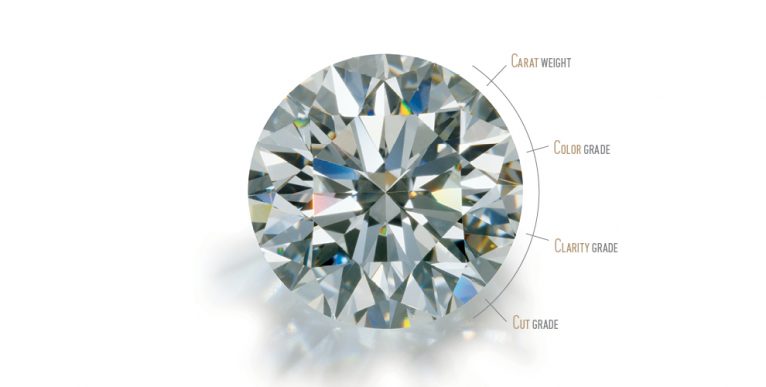
EL PESO
El peso en quilates es la medida utilizada para los diamantes.
Un "quilate" métrico se define como 200 miligramos. Cada quilate se subdivide en 100 "puntos". Esto permite mediciones muy precisas a una centésima parte de un decimal. Un joyero puede describir el peso de un diamante de menos de un quilate solo por sus "puntos". Por ejemplo, el joyero puede referirse a un diamante que pesa 0,25 quilates como un "punto veinticinco". Los pesos de los diamantes superiores a un quilate se expresan en quilates y decimales. Una piedra de 1,08 quilates sería descrita como "un quilate y ocho puntos".
En igualdad de condiciones, el precio de los diamantes aumenta con el peso, ya que los diamantes más grandes son más raros y más deseables. Sin embargo, dos diamantes de igual peso en quilates pueden tener valores muy diferentes (y precios) dependiendo de otros tres factores de los 4C del diamante: color, claridad y tamaño.
Si bien ahora sabes lo que significa un quilate, también es importante recordar que el valor de un diamante se determina usando todos los 4C, no solo el peso en quilates.
EL COLOR
Entender lo que significa el color del diamante ayuda a elegir el diamante correcto. Curiosamente, la evaluación del color de un diamante de calidad gema se basa en la ausencia de color. Un diamante químicamente puro y estructuralmente perfecto no tiene tonalidad, como una gota de agua pura, y por lo tanto un valor más alto.
El sistema de calibración de color D-to-Z mide el grado de color comparando una piedra bajo una iluminación controlada y condiciones de visualización precisas contra tonos de base, de un valor de color establecido.
Muchas distinciones de color de diamantes son tan sutiles que son invisibles para el ojo inexperto, sin embargo, estas distinciones hacen una gran diferencia en la calidad y el precio de los diamantes. Por lo tanto, es importante obtener el asesoramiento de un experto del GIA para guiarlo de la mejor manera posible, con pleno conocimiento de los hechos.
LA PUREZA
Para entender la pureza de los diamantes, primero debemos entender cómo se crean los diamantes. Los diamantes naturales son el resultado del carbono expuesto a un tremendo calor y presión en las profundidades de la tierra. Este proceso puede conducir a varias características internas llamadas "inclusiones" y características externas llamadas "imperfecciones".
Evaluar la pureza de un diamante implica determinar el número de impurezas, sus tamaños, su relieve, su naturaleza y la posición de estas características, así como cómo afectan a la apariencia general de la piedra.
Si está tratando de determinar cuál es la mejor claridad para un diamante, recuerde que ningún diamante es perfectamente puro. Pero cuanto más se acerca a la pureza, mejor es su claridad y mayor es su precio.
La Escala de Claridad de Diamante GIA incluye 6 categorías, algunas de las cuales se dividen, para un total de 11 grados específicos.
1 - Impecable (FL) Sin inclusiones y sin defectos externos visibles bajo aumento 10x
2 - Internamente impecable (IF) Ninguna inclusión visible bajo aumento 10x
3 - Inclusiones muy, muy pequeñas (VVS1 y VVS2) tan ligeras que son difíciles de ver para un comerciante de diamantes experimentado con aumentos de 10x
4 - Inclusiones muy pequeñas (VS1 y VS2) Las inclusiones se observan con dificultad bajo aumento 10x, y se pueden calificar como menores
5 - Inclusiones leves (SI1 y SI2) Las inclusiones son fácilmente visibles con un aumento de 10x
6 - Inclusiones (I1, I2 e I3) Las inclusiones son muy evidentes bajo aumento 10x, lo que puede afectar la transparencia y el brillo.
Muchas inclusiones e imperfecciones son demasiado pequeñas para ser vistas por alguien que no sea un Distribuidor de Diamantes Calificado. A simple vista, un diamante VS1 y un diamante SI2 pueden tener el mismo aspecto, pero estos diamantes son bastante diferentes en términos de calidad general. Es por eso que una evaluación experta y precisa de la claridad del diamante es extremadamente importante. Saber lo que significa la claridad del diamante realmente le ayuda a entender los factores que contribuyen a la calidad y el precio del diamante.
EL TAMAÑO
Los diamantes son reconocidos por su capacidad para transmitir luz y brillar intensamente. Consideramos el tamaño de un diamante según su forma (redondo, corazón, oval, marquesa, pera...). Se requiere una artesanía y un acabado precisos para dar forma a una piedra de modo que sus proporciones, simetría y pulido proporcionen el magnífico retorno de la luz posible.
Obtener el mejor corte para un diamante se refleja en la belleza y el valor final de la piedra. Y de todos los diamantes 4C, este es el más complejo y técnicamente difícil de analizar.
Para determinar la calidad de corte del diamante brillante "estándar redondo" - la forma que domina la mayoría de las joyas de diamantes - debe calcular las proporciones de estas facetas que influyen en la apariencia visible del diamante. Estas proporciones ayudan a medir cuál es el mejor tamaño para un diamante, estudiando qué tan bien interactúa un diamante con la luz para crear efectos visuales deseables, como:
1- Brillo: luz blanca interna y externa reflejada por un diamante
2- Fuego: La difusión de la luz blanca en todos los colores del arco iris
3- Centelleo: la cantidad de brillo producido por un diamante y el patrón de áreas claras y oscuras causadas por reflejos en el diamante.
La calidad de corte del diamante también tiene en cuenta el diseño y la fabricación del diamante, incluido su peso en relación con su diámetro, espesor, simetría de la disposición de las facetas y la calidad del pulido en esas facetas.
La escala de calidad de corte para diamantes de talla brillante "ronda estándar" en la gama de color de diamante D-to-Z contiene 5 grados que van desde excelente a pobre.
